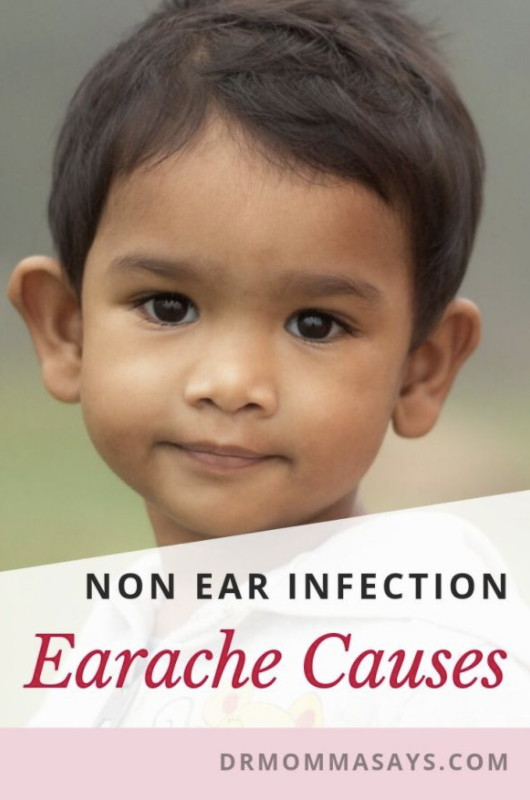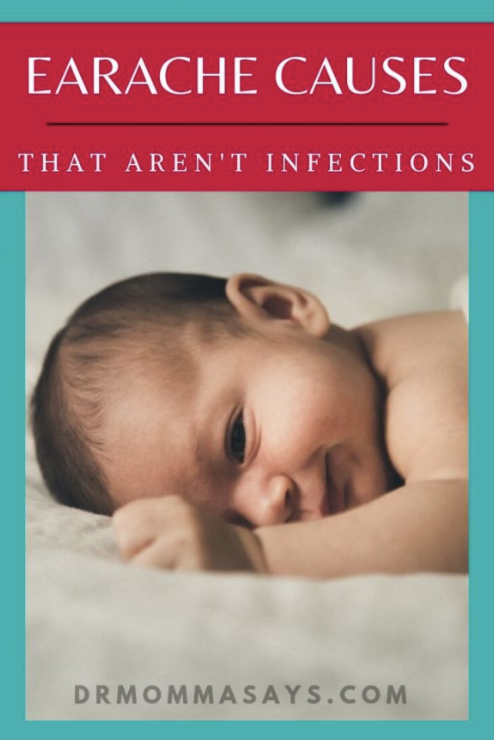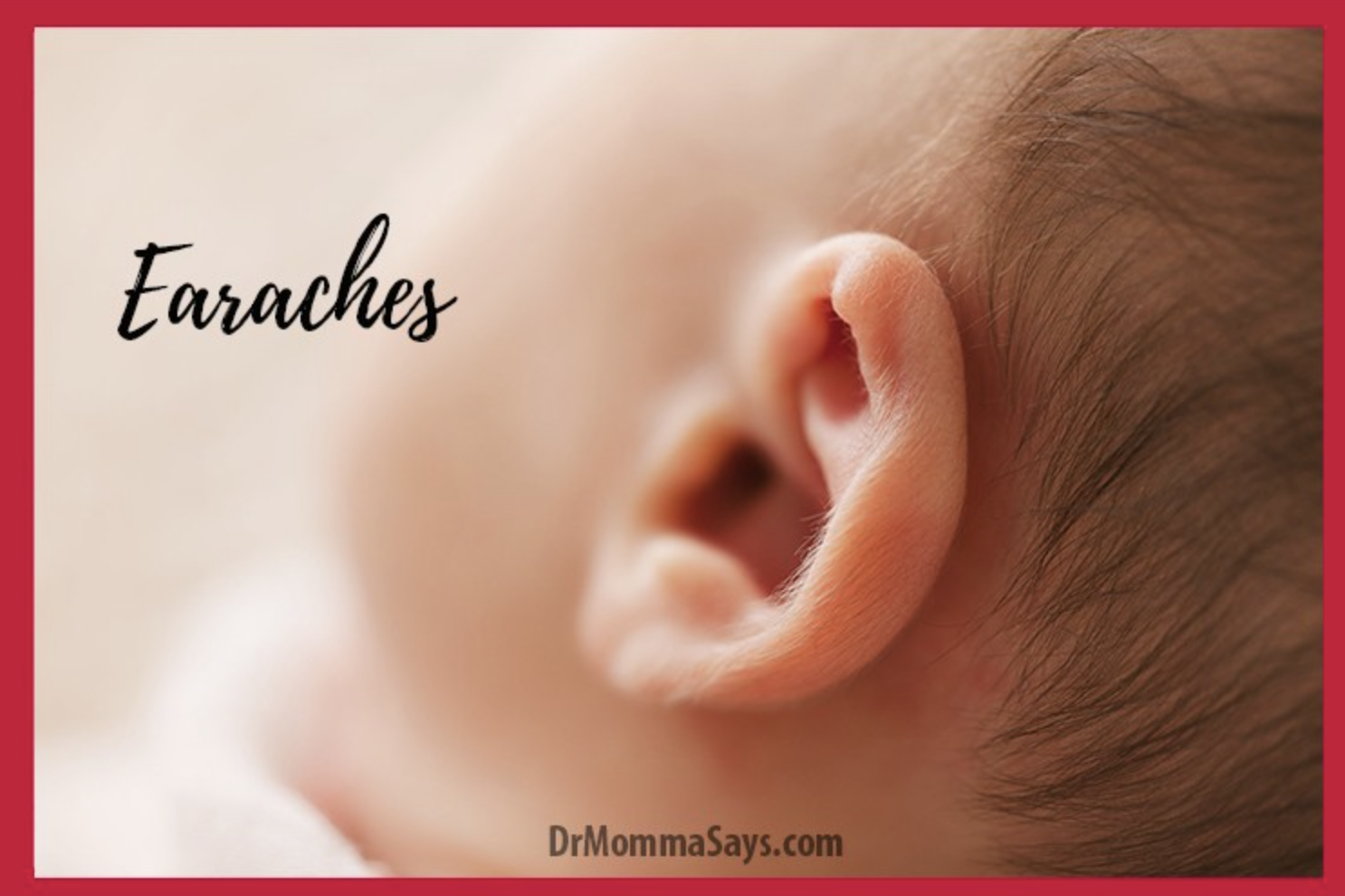A Dr. Momma Minute
An earache does not mean an ear infection. Now the fall has arrived, and cold and flu season are around the corner, it is an important time to remind parents that there are many earache causes. The purpose of this episode is to help parents understand the wide range of problems that can cause an ear to hurt.
It can be hard to determine the degree of pain in a child
Also, now is a good time for me to highlight that pain is personal. The louder your child cries does not always match the degree of an injury or infection. I think we all know kids who scrape their knee and then limp for days, showing the scabbed over skin for a week.
In fact, I had such a child. I kept a drawer of colorful bandaids that I collected every time I saw them. Princess. Cartoon. Sparkles. You name it, we had it.
We also had something called a Boo-Boo Bunnie (See link at bottom of post) that was a plastic re-freezable ice cube surrounded by a soft covering. This was kept in a freezer that my child could access. Whenever drama would happen or something was scraped, after hugs and kisses were given, I directed my child to the bandaid drawer or suggested she go find “Boo Boo”.
Happily, my child forgot her pain as she grabbed that little bunny and held it to her skin as she searched the bandaid drawer for the perfect treatment. Often, there were multiple bandaids placed on different parts of her body. I stopped trying to put the bandaids on since she would angrily tell me that I did not put in on the right spot. (I mean, was it my fault that I could not see the cut, scrape or injury that led to screams and tears?)
My point: you need to understand who your child is. Louder cries do not mean a more severe medical problem. On the other hand, I have met kids with bulging ear infections with no symptoms; and some even rupture their eardrums before parents knew an issue was present. For these kids with high pain tolerance, parents need to monitor for more subtle symptoms such as repeated ear pulling and head shaking.

Ear infections are one group of earache causes
I have already shared many (many, many many) posts which discuss different ear infection facts, chronic middle ear fluid (including the dreaded glue ear), methods to prevent or reduce ear infections, and severe complications. I also shared important information about surgery for ear infections and gave more information that you may ever need to know about ear tubes and the severe complications associated with ear tubes.
Despite the need for me to insert ear tubes in children every week, most kids do not need ear tubes. Most ear infections will go away on their own without the need for antibiotics. In fact, you should praise and celebrate your physician for not giving you unnecessary medications! Check out the post by pediatrician Dr. Christina Johns who shares some significant side effects and complications of antibiotics.
Also, remember that most ear infections happen when a child gets a cold, which is a viral infection. Last year I wrote a post about hilarious myths about the common cold, not because they really are funny, but because I want you to laugh them away every time you hear them. Bottom line, colds may result in many complications and treatments may be needed; however, you must remember that antibiotics will never treat a viral infection. Just saying.
Because ear infections are so common, many parents look at ear tubes as a way to get rid of them. Let me say out loud for everyone: Ear tubes do not stop ear infections, they make the symptoms less severe and give another way to treat them, with ear drops instead of antibiotics. They do an excellent job of getting rid of severe earaches though!
Having an accurate diagnosis is extremely important. A red ear does not mean ear infection just as earache does not mean ear infection. Red throat does not mean strep infection, does it? Of course not. Check out a post by a pediatrician who shares the difficult process of diagnosing ear infections.
Most people assume earaches and ear pain happen only to children, but they can also happen to adults. An earache may affect one or both ears, but most of the time it is only in one ear. The pain may be dull, sharp, burning, may feel constant or come and go; however, the type of pain does not tell physicians the cause.
Earache causes can be grouped into two categories: Primary and Secondary

Primary earache causes
The primary earaches causes have a problem that starts in the ear, but this does not mean they are all ear infections. The ear has many more problems than just infections.
There are different areas of the ear, and I always remind parents to ask their treating physicians which part of the ear is infected or involved. The management is different in different areas.
A small sample of primary earache causes include:
- Outer ear infections (swimmers ear, fungal infections)
- Middle ear infections (acute infections, chronic ear fluid)
- Inner ear infections
- Eustachian tube swelling (due to nasal congestion and blockage)
- Skin disorders of the ear (eczema, psoriasis)
- Ear wax impaction (made much worse by using Qtips)
- Ear foreign body (anything, including broken off heads of Qtips!)
- Inflammation of cartilage of the ear
- Tumors
Secondary earache causes
These conditions may cause ear pain which sends you to see your physician, but the real problem is happening outside of the ear area. I usually call this referred pain which can happen all over the body when a problem is giving symptoms in a different area.
A sampling of secondary earache causes includes:
- Allergies and other nasal disorders
- Sinus infections
- Dental problems
- Jaw joint problems
- Tonsillitis and pharyngitis
- Gastroesophageal reflux
- Tumors
Some home options that improve some earache causes:
- Apply a cold washcloth to the ear.
- Avoid getting the ear wet.
- Sit upright to help relieve ear pressure.
- Use over-the-counter wax softening
- Take over the counter pain relievers.
- Chew gum to help relieve pressure.
- Feed an infant to help them relieve their pressure.
- Immediately stop using Qtips in the ear (Just saying)
You can take several steps at home to try to reduce earache pain. BUT the reason many don’t work is that you are not treating the right problem. Please see your physician and discuss your specific problem so that an accurate diagnosis and treatment plan can be set up.
As always, much love for supporting my work. I will be adding many more posts to highlight parenting and healthcare tips, so be sure to consider subscribing to my podcast or to my blog to avoid missing a post…or a Dr. Momma Minute!
Resources:
An Amazon affiliate link where your price does not change, but I receive a small referral fee.
Excellent posts about ear infections and ear pain by fellow physicians (aka reliable and science-based). And feel free to browse on their sites for other great healthcare topics.
- Dr. Jaime Friedman: The Dreaded Ear Infection
- Dr. Kristin Stuppy: Swimmers Ear, Ear Wax
- Dr. Ned Ketyer: Leave Those Ears Alone
- Dr. Paul Smolen (Doc Smo): Ear Pain Solved by Dr. Mom
 Back to Blog Homepage
Back to Blog Homepage